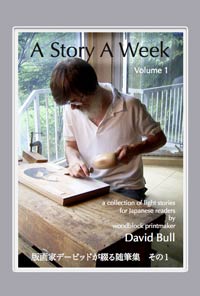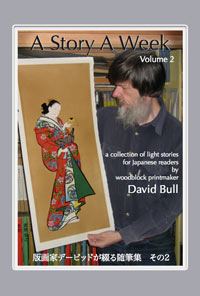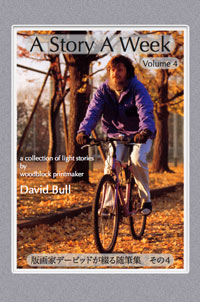Dots and Lines
I am writing the stories for this issue of the Hyakunin Issho newsletter during the final week of December, snatching some time away from my carving bench to do so. The job in progress on the bench this week is a group of blocks to do the colour printing on the upcoming print in the 'My Solitudes' series. The design isn't ready to show you yet, but part of the image involves a rock in the river with a stream of water sliding past it. I want the rock to look fairly natural, so these colour blocks will all have areas of carved wood that represent texture and shading on the rock.
Here's a closeup of part of the tracing that will guide the carving for one of this group of blocks:
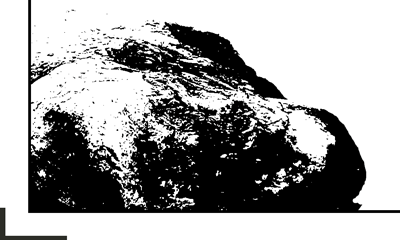
Look at all those little dots! And this is just part of just one of the blocks! And of course, the way woodblock printmaking works is that those dots represent the wood that is left behind; I have to carve away all the wood around them in order for the patterns to print properly.
As you may expect, this is taking me quite some time. All this week, while most people all over this country are running around this way and that getting their year-end preparations done, I am sitting here in my workshop for hour after hour after hour, looking down through my magnifying glass and cutting thousands of tiny dots.
Does this make sense? Isn't there a better way to do this?
***
For many years now, people in various occupations in society have had to face the threat of having their jobs taken over by machines. Actually, this goes back a couple of hundred years to the beginning of the industrial revolution, but it is only since computers became very common that basically everybody has had to be concerned about this sort of thing. In a great many cases, when the question arises, "Should we do this by hand, or by machine?", the answer is obvious. Our modern telephone system couldn't possibly work if we still had rooms full of young women plugging all the connections manually, and we couldn't build our modern cities without giant machines to dig and carry for us. There is absolutely no question that the efficiencies of mechanization are what make our contemporary society possible.
For companies (and individuals) in this modern world, when the opportunity arises to use machines or computers to do a job that was previously done by hand, the answer to the question usually comes down to an analysis of a couple of points; is it cheaper to do it by hand or by machine, and is the final product better when made by machine.
 Because machines and computers are becoming so advanced these days, most products we see around us are now far more well-made than they used to be, and far more inexpensive too. A modern automobile, just for one example, is an incredibly efficient machine. Don't you remember how frequently cars used to break down, and how much maintenance they always needed?
Because machines and computers are becoming so advanced these days, most products we see around us are now far more well-made than they used to be, and far more inexpensive too. A modern automobile, just for one example, is an incredibly efficient machine. Don't you remember how frequently cars used to break down, and how much maintenance they always needed?
And yes, even in this marginal field of woodblock printmaking, mechanical methods are creeping closer and ever closer. Many of the famous prints made by the Yoshida family (Hiroshi and Toshi) are printed from 'blocks' that are actually metal, produced quickly and easily from their drawings without being carved. And a couple of years ago, I saw small inexpensive woodblocks for sale in a stationery store for printing new year card designs, which had been carved automatically by laser.
So, putting all these points together ... that the technology exists to produce these dots easily and cheaply - that the end product would be no worse, and perhaps improved - and that I would be able to 'save time' for doing other tasks ... what would you recommend? Should I switch to an automated system, or continue carving such things by hand?
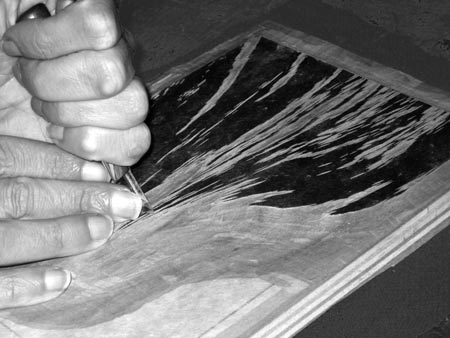
Now of course, I'm not really asking for your opinion on this, so you have no need to answer. I made my decision on this many years ago, in the earliest days of my woodblock printmaking adventure, when I was working on Tenji Tenno, the first of the 100 prints of the Hyakunin Isshu that I made. It was 1989; I was still relatively inexperienced at woodblock printmaking, and - of course - I had no idea that I would still be doing the same thing nearly two decades later. As I worked on that print, I had so many ideas about how to 'improve' the process!
"If I put a screw adjustment device at that corner of my printing bench, I would be able to make the 'kento' adjustments very easily, with just a tiny turn of a dial!"
"If I build an overhanging arm on the bench with a clamp on it to hold the knife, I could cut the straight lines on this print very quickly and accurately!"
"If I design some kind of holder for the inner disc of the baren, I would be able to tie the outer cover in place much more easily!"
Well, did I build any of those tools to help me with the work? No. And the reason I didn't, is that I asked - and answered - a much more important question first, the question "Why am I making woodblock prints?" And the answer was not the same as the craftsmen in the old days would have answered. They would have replied "Why make woodblock prints? ... It's our job! People will buy them, and will enjoy them. That's our function in this society."
But my answer must be different, "The purpose of making woodblock prints is ... to enjoy the process of making woodblock prints ... of course! People may also buy them, and hopefully will enjoy them."
For the men of the old days, working as quickly and efficiently as possible was vital; if tools for better carving had become available, there is no question that they would have been used. And of course, this is actually what happened; the invention and development of the printing press completely took over the process.
But for me efficiency is not a consideration. As I keep telling people (and they nearly always think I'm joking), "If you like doing something, isn't it better if it takes a long time?"
And honestly speaking, I rather suspect that more than a few of those people who are out there this week running around to get their year-end chores done in time wouldn't mind changing places with me, don't you think?
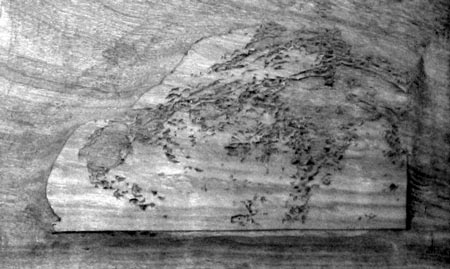





 Because machines and computers are becoming so advanced these days, most products we see around us are now far more well-made than they used to be, and far more inexpensive too. A modern automobile, just for one example, is an incredibly efficient machine. Don't you remember how frequently cars used to break down, and how much maintenance they always needed?
Because machines and computers are becoming so advanced these days, most products we see around us are now far more well-made than they used to be, and far more inexpensive too. A modern automobile, just for one example, is an incredibly efficient machine. Don't you remember how frequently cars used to break down, and how much maintenance they always needed?

